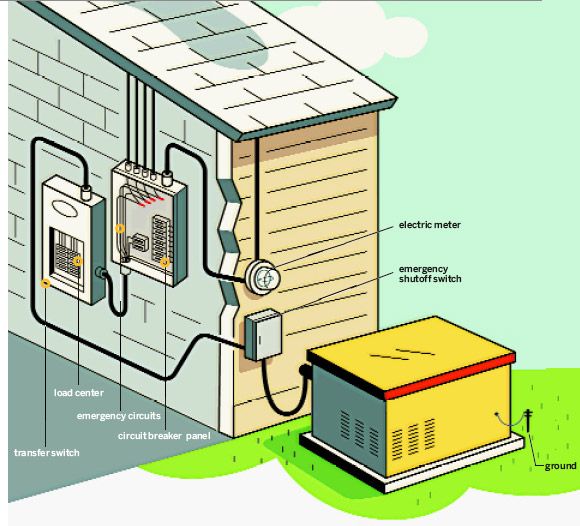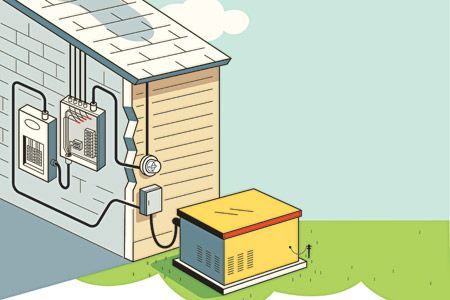
Standby generators keep your home running during storms and power outages. These units automatically start when the power goes out, keeping your lights on, your food fresh, and your family comfortable. Our guide explains how standby generators work to help you determine if they’re the right solution for your emergency power needs.
What Is a Standby Generator?

A standby generator is a stationary backup power system that activates within seconds of a power failure, ensuring minimal disruption to your daily life. Unlike portable generators that require manual setup and fueling, standby generators are permanently installed outside your home and connected directly to your electrical system. They typically run on natural gas, propane, or diesel fuel, allowing them to operate for extended periods without refueling.
Based on the unit’s capacity, standby generators power multiple circuits in your home, from essential appliances like refrigerators and sump pumps to entire homes.
Key Components of a Standby Generator
A standby generator system consists of several crucial components that work together to provide reliable backup power:
- Alternator: Converts the engine’s mechanical energy into electrical power
- Control panel: Monitors utility power and manages the generator’s operation
- Enclosure: Weather-resistant housing that protects the generator’s internal components
- Engine: The heart of the generator, responsible for producing mechanical energy
- Transfer switch: Automatically disconnects your home from the utility grid and connects it to the generator
How Standby Generators Operate During Power Outages
Standby generators are designed to transition from grid power to backup power seamlessly. Here’s a breakdown of how they work during an outage.
Detecting Power Loss
Standby generators have sophisticated sensors that constantly monitor the incoming utility power. These sensors can detect even momentary fluctuations or complete loss of power from the grid. The generator’s control system instantly detects significant power events, such as blackouts.
Initiating Backup Power
The standby generator springs into action when the system detects a power loss. The engine starts automatically, typically within 10–30 seconds. The generator begins producing electricity, and the automatic transfer switch disconnects the home from the grid and connects it to the generator. This process happens so quickly that many homeowners may only experience a brief flicker of lights before their power is fully restored.
Restoring Grid Power
When utility power returns, the standby generator doesn’t immediately shut off. Instead, the system detects the restored grid power and waits for a short period (usually a few minutes) to ensure the power is stable. The automatic transfer switch reconnects the home to the grid, and the generator continues to run for a cool-down period before shutting off. This process ensures that your home doesn’t experience repeated outages due to unstable grid power after a major event.
Sizing Your Standby Generator
Choosing the right size generator ensures that your essential appliances and systems receive adequate power during an outage. A smaller generator will only meet your needs, while an oversized unit can be unnecessarily expensive to buy and operate.
Calculating Power Needs
To determine the appropriate size for your standby generator, list all the appliances and systems you want to power during an outage. Note the starting and running wattage for each item. Calculate the total wattage needed, including a 20% cushion for unexpected loads.
Consider working with a professional electrician or generator installer to accurately assess your power requirements. They can help you account for motor start-up surges and potential future needs.
Common Household Appliance Wattages
To help you estimate your generator needs, we’ve provided some typical wattages for common household appliances.
- Central air conditioner (3 ton): 3,000–5,000 watts (W) running, 7,500–12,500 W starting
- Gas furnace (with 1/2-hp fan): 700–800 W running, 1,400–2,350 W starting
- Lights: 60–75 W running, same as running watts (no surge)
- Refrigerator: 300–800 W running, 1,200–2,200 W starting
- Television (large): 100–400 W running, same as running watts (no surge)
- Window air conditioner: 500–1,500 W running, 1,500–4,500 W starting
These are average figures, and your specific appliances may vary. Always check the manufacturer’s specifications for accurate wattage information.
Fuel Options for Standby Generators
Standby generators can run on various fuel types, each with its own advantages. The choice of fuel depends on availability, cost, and personal preference. Consider factors like fuel availability, storage capabilities, and local regulations when selecting a fuel type.
Natural Gas Generators
Natural gas is a popular fuel choice for standby generators, especially in urban and suburban areas where natural gas lines are readily available.
Advantages:
- Clean-burning and environmentally friendly
- Continuous fuel supply through existing gas lines
- Generally lower fuel costs compared to propane or diesel
Drawbacks:
- Gas supply could be interrupted during some emergencies
- May not be available in all areas
- Requires a natural gas connection
Propane Generators
Propane is another common fuel option, particularly in areas without natural gas service.
Advantages:
- Burns cleanly with low emissions
- Can be stored indefinitely without degradation
- Portable tanks allow for flexible installation
Drawbacks:
- Higher fuel cost compared to natural gas
- Limited runtime based on tank size
- Requires regular refilling of propane tanks
Diesel Generators
Diesel generators are often used for larger residential or commercial applications.
Advantages:
- Can handle heavy loads
- Diesel fuel has a long shelf life
- Highly efficient and long-lasting
Drawbacks:
- Higher initial cost
- Noisier operation compared to natural gas or propane
- Requires regular fuel delivery and storage
Standby Generator Installation Considerations
Several important factors affect safety, efficiency, and local code compliance when planning your generator installation.
Placement and Safety Concerns
The location of your standby generator directly impacts safety and performance. You should place generators at least 5 feet from doors and windows to prevent carbon monoxide from entering the home. Ensure easy access for maintenance and refueling (if applicable), and adhere to local zoning laws and building codes regarding generator placement. If you live in a flood-prone area, install the generator above potential flood levels to prevent water damage.
Proper ventilation, fuel line installation, and electrical connections are safety considerations. Always work with a licensed electrician and follow manufacturer guidelines for installation.
Noise Reduction Strategies
Modern standby generators operate quietly, but noise can still concern some homeowners and neighbors. Local noise ordinances may also dictate acceptable decibel levels for residential areas. Consider these noise reduction strategies:
- Landscaping: Use plants or fencing to create natural sound barriers
- Scheduled maintenance: Regular upkeep ensures quieter operation
- Sound-attenuating enclosures: Many generators come with built-in sound-dampening features
- Strategic placement: Position the generator away from outdoor living areas and neighbors’ properties
Standby Generator Maintenance and Testing
A well-maintained generator can last 15 years or more, providing peace of mind through numerous power outages. Here are some maintenance tips to make sure your standby generator performs reliably when you need it most.
Routine Maintenance
Change the oil and oil filter according to the manufacturer’s schedule. Replace air filters regularly, check and clean spark plugs, inspect and tighten all electrical connections, monitor coolant levels in liquid-cooled models, and keep the exterior clean and free of debris. Many homeowners opt for professional maintenance contracts to ensure these tasks are performed correctly and on schedule.
Regular Testing
Most units are programmed to run a self-test weekly, typically lasting about 20 minutes. This test ensures that the generator starts properly and can handle the expected load.
During these tests, listen for any unusual noises, check for leaks or visible damage, and ensure the generator switches back to standby mode correctly. If you notice any issues during testing, contact a professional for inspection and repair.
Standby Generator Cost Factors and Return on Investment (ROI)
Investing in a standby generator is a big decision. Carefully consider both the upfront cost and long-term benefits.
Initial Investment
The cost of a standby generator varies widely based on its size and capacity, fuel type, and installation complexity. The brand and additional features also impact price. Homeowners can expect to pay between $1,542 and $8,759 for a complete standby generator system, including installation.* Smaller units may start around $2,000–$6,300, while larger, whole-house systems can exceed $18,000.
*Cost data sourced from Angi.
Long-Term Savings and Benefits
Despite the high initial cost, standby generators offer several long-term benefits. They protect against food spoilage during extended outages, prevent basement flooding by keeping sump pumps operational, and allow you to work from home during power outages. They can also increase home value and marketability and provide peace of mind during severe weather events.
Additionally, some insurance companies offer discounts for homes with standby generators, potentially offsetting some of the cost over time.

